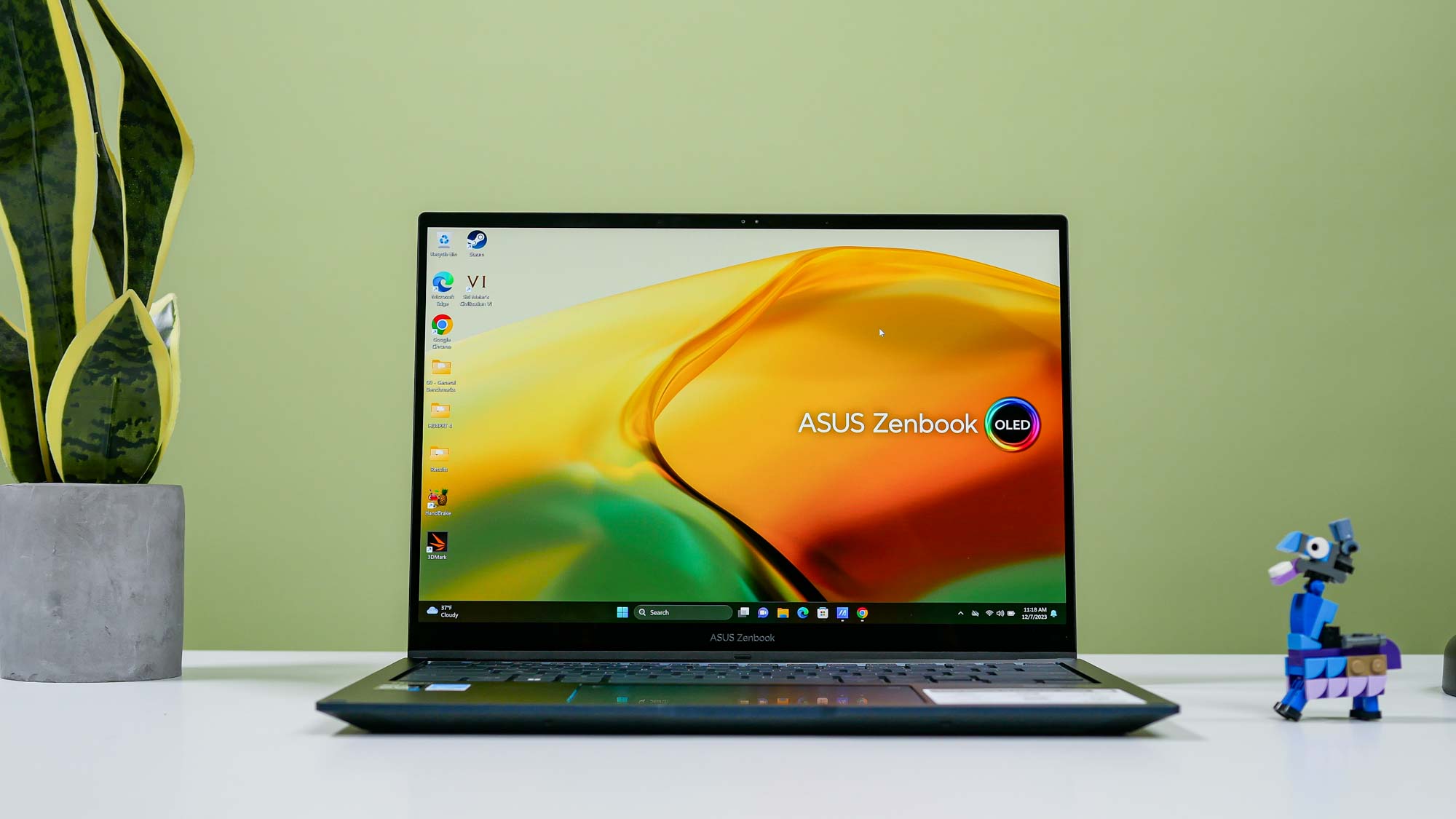
The Asus Zenbook 14 Flip OLED (starting at $999) is arguably one of the best 2-in-1 laptops for the money. It’s a fetching and sturdy ultraportable with plenty of ports, plenty of power, and a vivid 2.8K OLED panel. On top of that, it also has an LED number pad on its touchpad — which is a nice touch.
From its gorgeous display and elegant design to overall usability, there’s a lot to like about the Asus Zenbook 14 Flip OLED. In fact, it’s now my favorite 2-in-1 that I’ve reviewed — combining everything that makes the best Windows laptops and the best tablets so appealing. It’s also a phenomenal value for what you get. Find out more in my full review.
Asus Zenbook 14 Flip OLED review: Specs
Asus Zenbook 14 Flip OLED review: Price and configuration
- Starts at $999
- High-end model costs $1,199
The Asus Zenbook 14 Flip OLED is available for a starting price of $999 on Asus’ website. This configuration features a 14-inch 2.8K (2,880 x 1,800) OLED 16:10 touch display, a 13th Gen Intel Core i5-1340P CPU, 16GB of RAM and 512GB of SSD storage. This model is only available in Foggy Silver.
The high-end $1,199 model we reviewed has the same display, RAM and storage as the entry-level version, only it packs a 13th Gen Intel Core i7-1360P processor and comes in Ponder Blue.
Asus Zenbook 14 Flip OLED review: Design
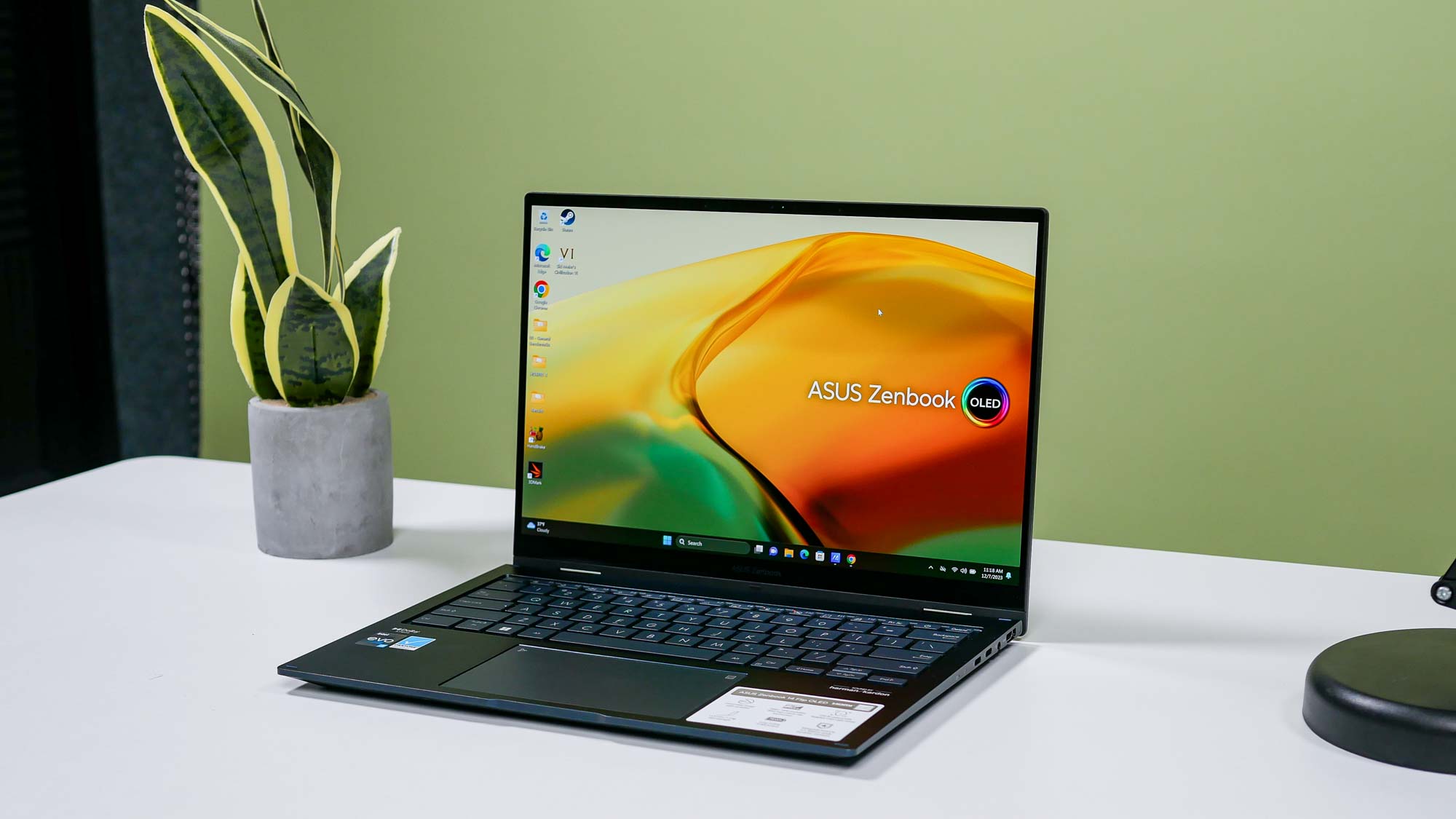
- Thin and light
- Minimalist design
The Asus Zenbook 14 Flip OLED features a minimalist aesthetic that’s equally stylish and subdued. Save for a few lines across its lid, there are no embellishments across the laptop’s aluminum alloy chassis. This is a machine that won’t look out of place at the office or your favorite cafe.
Opening and closing the laptop isn’t a problem. Flipping the lid 360 degrees to enable tablet mode is also effortless. With a smooth surface, it feels great to hold in both configurations. One downside is that the display might flip backward if you move the Zenbook 14 Flip too much while you’re walking. This isn’t a big deal, but it’s something to keep in mind.
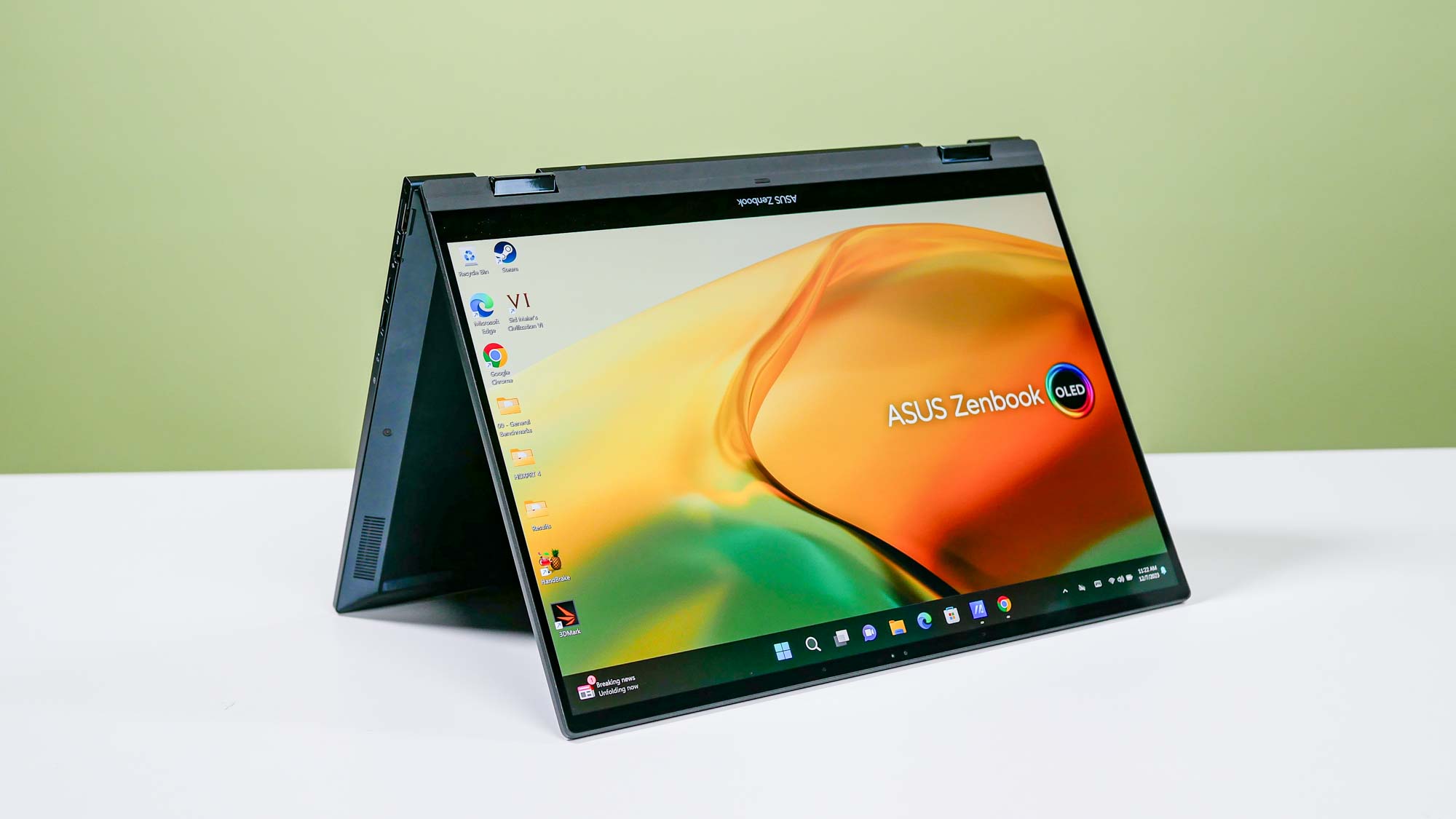
At 12.2 x 8.8 x 0.6 inches and 3.3 pounds, the Zenbook 14 Flip makes for a perfect travel laptop. It’s thin and light enough that you might forget it’s in your backpack. It’s also not a chore carrying it from room to room. The 13-inch MacBook Air M2 weighs less at 2.7 pounds, but Asus’ notebook is still very light.
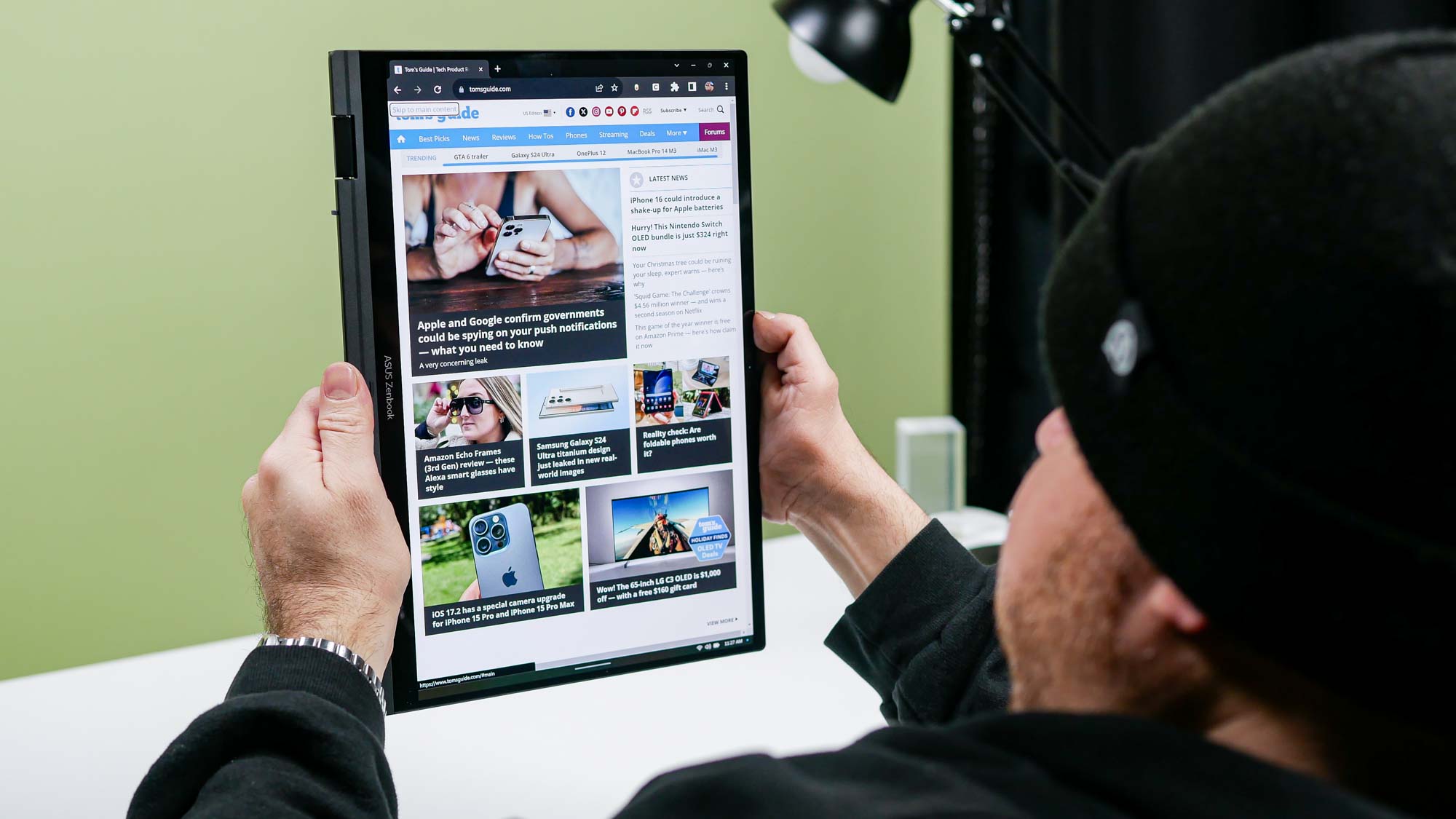
While the Zenbook 14 Flip’s design makes for a sleek and light laptop, the same isn’t true when it’s in tablet mode. Holding the folded device is a cumbersome experience since your fingers are always pressing against the keys on the back. The Zenbook 14 Flip can also feel heavy in your hands after a few short minutes. This is an issue I have with almost all convertibles, for what it’s worth.
Asus Zenbook 14 Flip OLED review: Display
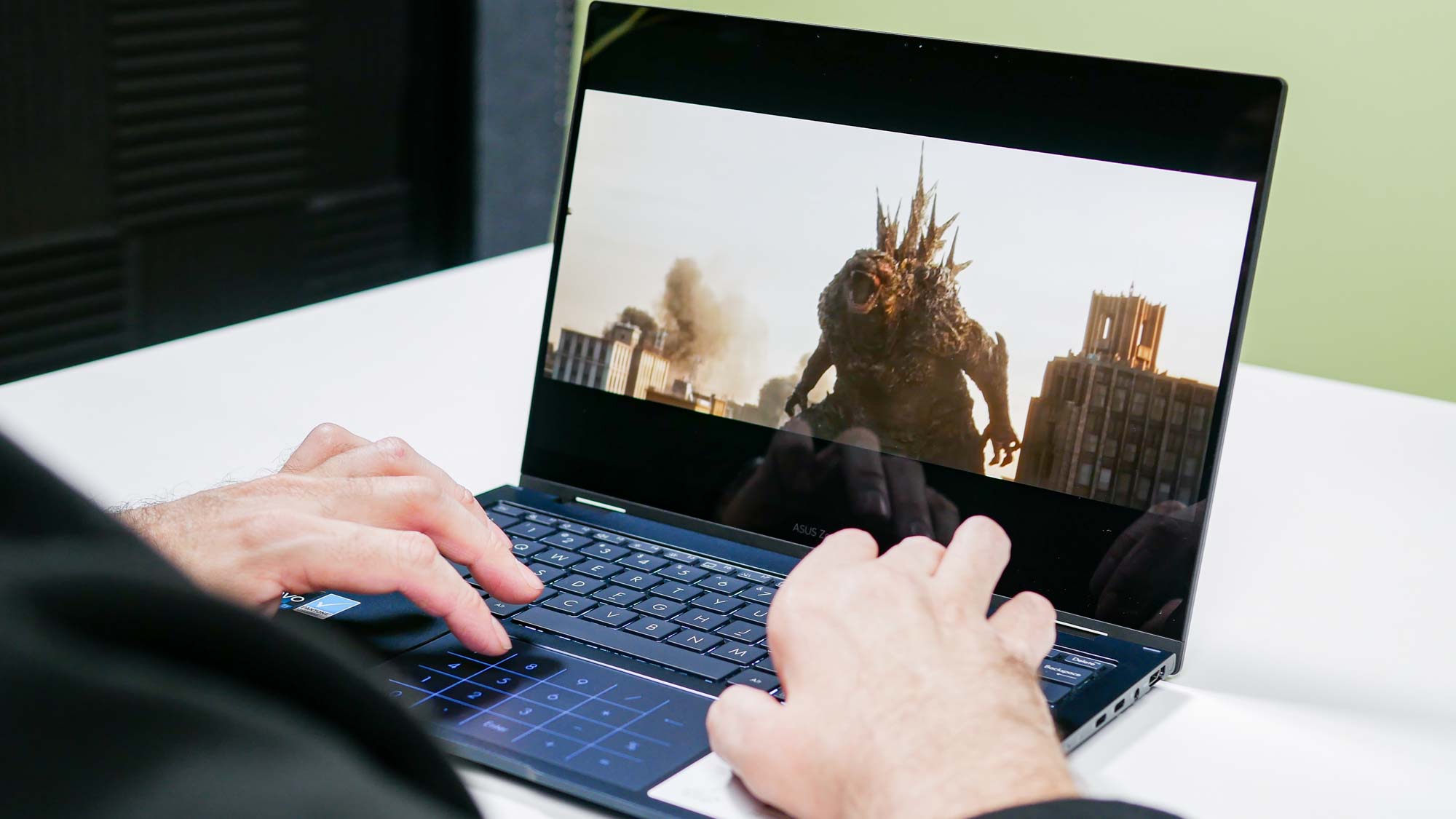
- Vibrant OLED panel
- Doesn’t get overly bright
The OLED panel is one of this laptop’s main selling points. The inky blacks and vibrant colors make everything from flashy YouTube videos to simple web pages look stellar. Images are generally well-illuminated, though I’ve tested brighter displays. But overall, I have little to complain about with this gorgeous display.
During testing, I fired up the trailer for Godzilla Minus One — which is the best atomic bomb movie of 2023 (sorry, Oppenheimer!). The sharp 2.8K panel was adept at showing every minute detail of the devastated streets of Tokyo. The movie’s iteration of Godzilla, with his scarred craggy hide, also appeared lifelike. Atomic breath blasts and the resulting devastation proved impressive. Plus, the 90Hz refresh rate ensured everything moved buttery-smooth.
Our lab tests aligned with my anecdotal experience. Using our colorimeter, we found that the screen achieves 111.5% of the sRGB color gamut and 83.2% of the more demanding DCI-P3 color space (the closer to 100% on both, the better). These values are comparable to the Samsung Galaxy Book 3 Pro 360 (120.2% / 85.2%). However, the Lenovo Yoga 9i Gen 8 (200.6% / 142.1%) delivers more oversaturated colors, which some might prefer.
Asus’ notebook scored 0.2 in the Delta-E color accuracy test (0 is best), which aligns with the Galaxy Book 3 Pro 360 and most OLED laptops I’ve reviewed. This is a better score than the Yoga 9i Gen 8, which features slightly less accurate colors.
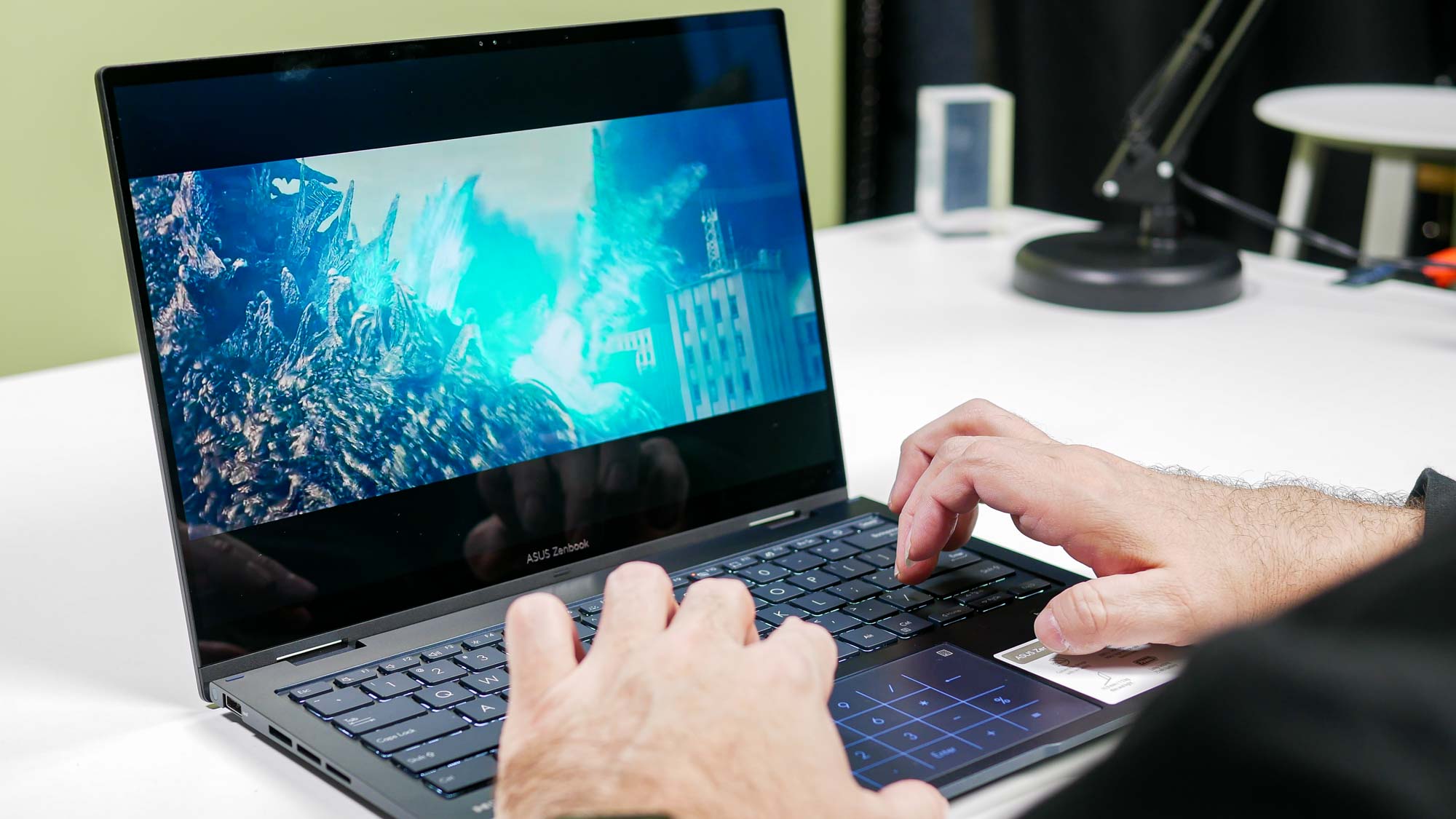
Asus claims the Zenbook 14 Flip can reach 550 nits of brightness. According to our display test, however, the screen averages 339 nits of brightness. This is dimmer than both the Galaxy Book 3 Pro 360 and Yoga 9i Gen 8, though the gulf isn’t as wide. While the display isn’t the brightest, the generally rich picture quality helps alleviate that aspect.
Though using this convertible as a tablet isn’t always comfortable, its touchscreen functionality is nearly perfect. Scrolling through websites and tapping through menus feels intuitive. Windows 11 works well with touch displays so I wasn’t surprised to find the touchscreen as responsive as the touchpad.
Asus Zenbook 14 Flip OLED review: Audio
- Speakers don’t get loud
- Lacks bass
The Asus Zenbook 14 Flip OLED’s downward-facing dual speakers aren’t very loud. Mids and highs are decent enough, but bass is practically non-existent. Podcasts won’t offend your ears since voices come through clearly. However, I wouldn’t recommend listening to music on this laptop’s speakers due to the overall thin and weak sound.
The speakers on the Zenbook 14 Flip are good enough in a pinch but you’re better off using a pair of the best wireless headphones.
Asus Zenbook 14 Flip OLED review: Ports

- Decent amount of ports
Ultraportable laptops can sometimes skimp on ports to maintain a thin profile. Thankfully, that’s not the case with the Zenbook 14 Flip OLED. I won’t say it has an abundance of ports, but it has enough for most people.
The majority of ports reside on the laptop’s right side. Here, you’ll find a pair of Thunderbolt 4/USB-C ports, a 3.5mm headphone jack and an HDMI port. Over on the left side, you’ll find a lone USB-A port.
Asus Zenbook 14 Flip OLED review: Keyboard, touchpad and Asus Pen 2.0
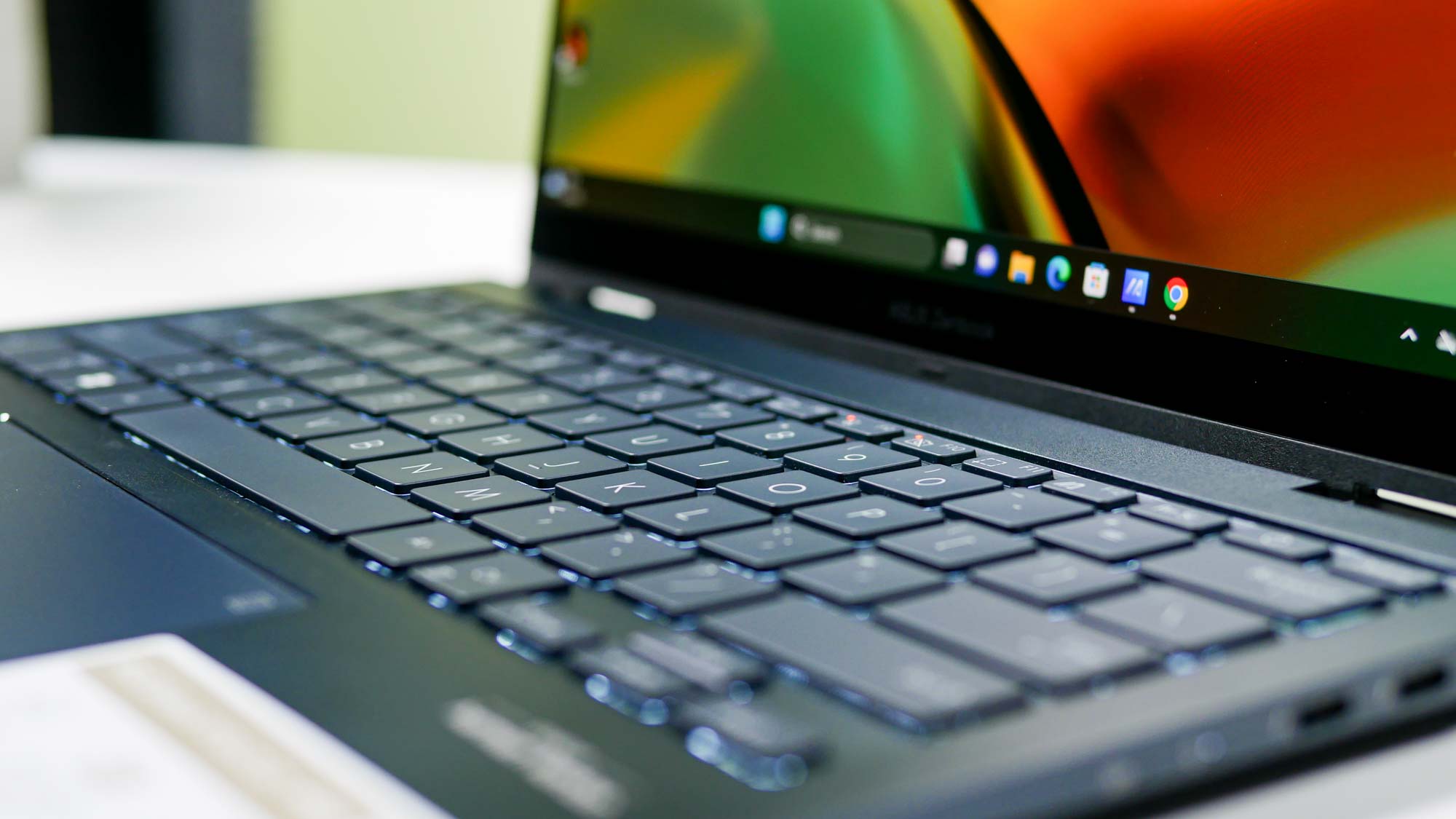
- Comfortable keyboard
- Backlit LED Numbpad on touchpad
The Asus Zenbook 14 Flip OLED has a fantastic keyboard — featuring thick keycaps, satisfying travel distance and good key spacing. The keys provide nice resistance when pressed and remain quiet even with hard keystrokes. I also liked the spacious keyboard deck.
As I mentioned above, the touchpad features a backlit LED number pad, which you can enable or disable by pressing a keyboard icon on the touchpad’s upper right corner. If you regularly use the number pad on a keyboard, then you’ll no doubt appreciate this handy feature. It’s also just plain cool to watch it light up.
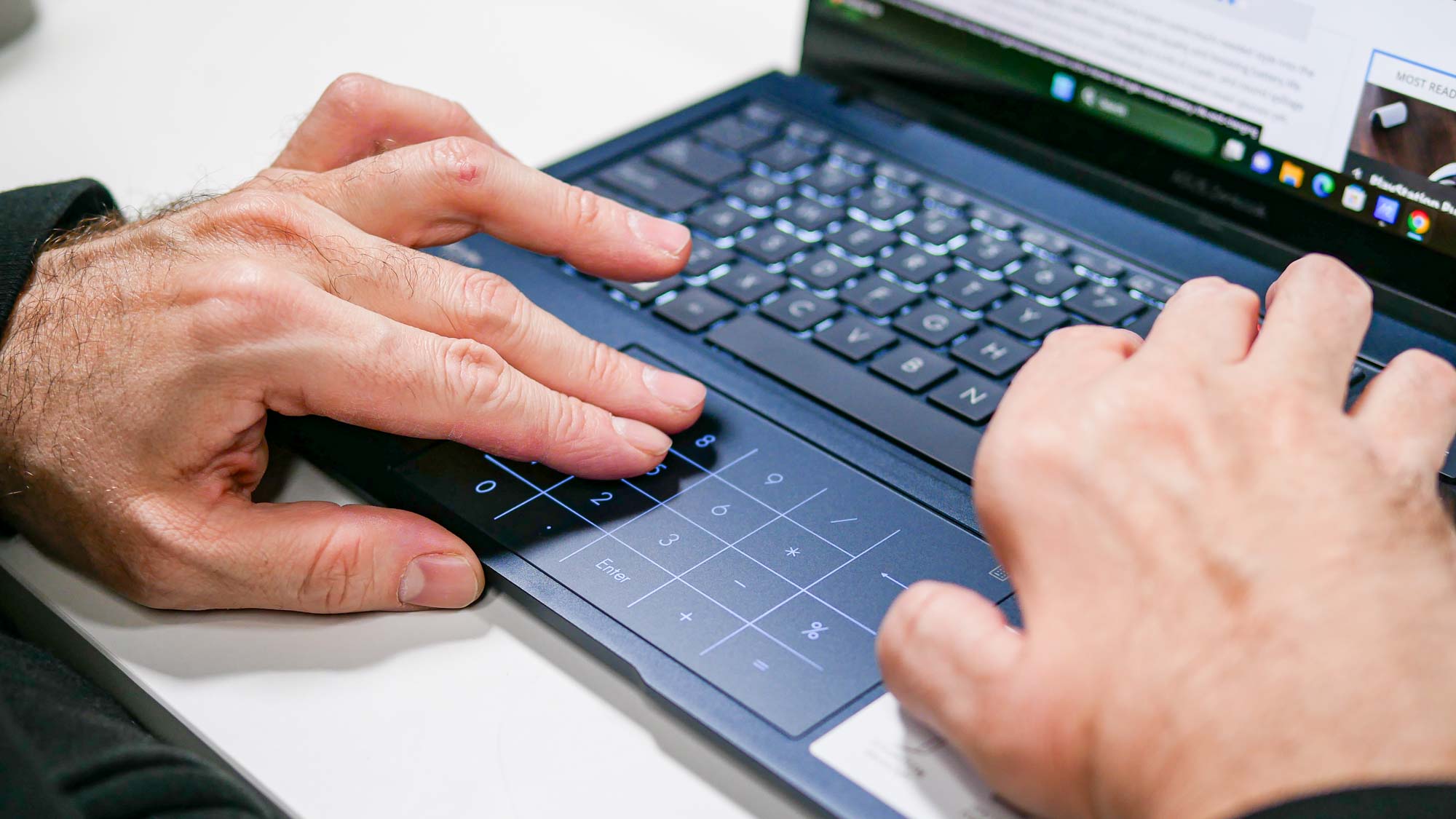
With a smooth and responsive surface, the touchpad never failed to recognize my gestures. Its large size made it easy to use and I never accidentally swiped it when typing. Clicking on the touchpad was also enjoyable.
The included Asus Pen 2.0 also works nicely with the touchscreen. Its sensitivity and range of tip force allow you to draw lines of different thicknesses. That aspect will no doubt appeal to artists or even note-takers. As for the pen itself, I found it comfortable to use. It’s a neat Apple pencil alternative, though I still prefer Apple’s stylus.
Asus Zenbook 14 Flip OLED review: Performance
- Fast performance
- Not great for gaming
The Asus Zenbook 14 Flip OLED is a thin laptop in design but not performance thanks to its 13th Gen Intel Core CPU and 16GB of RAM. That’s not to say you’ll tear through video projects or comfortably play the best PC games on this notebook. Far from it. But as a productivity machine for everyday work, web browsing and video watching, the Zenbook 14 Flip delivers.
I typically have anywhere between 20 to 30 open tabs while working. Despite that, and running a YouTube video in the background, I never experienced a notable dip in performance. This laptop could easily be my daily driver, both for work and leisure thanks to its solid performance.
How did the Zenbook 14 Flip OLED fare in our lab tests? On Geekbench 6, which measures CPU performance, it notched a multi-core score of 10,069. As you can see from the table above, that score isn’t far off from other laptops featuring a 13th Gen Intel Core i7-1360P CPU. The $1,449 Samsung Galaxy Book 3 Pro 360 is slightly slower while the $1,049 Lenovo Yoga 9i Gen 8 is faster, based on our testing.
Moving over to our SSD test, which tasks a laptop with duplicating 25GB of multimedia files as fast as possible, Asus’ convertible had a transfer rate of up to 1,076 MBps. That’s much worse than the Yoga 9i (1,669 MBps) but not far off the Galaxy Book 3 Pro (1,173 MBps).
Lastly, in our video editing test, which consists of transcoding a 4K video down to 1080p using Handbrake, the Zenbook 14 Flip jogged along and took minutes and 9 minutes and 17 seconds. That’s 32 seconds faster than the Yoga 9i (9:45) but over a minute slower than the Galaxy Book 3 Pro 360.
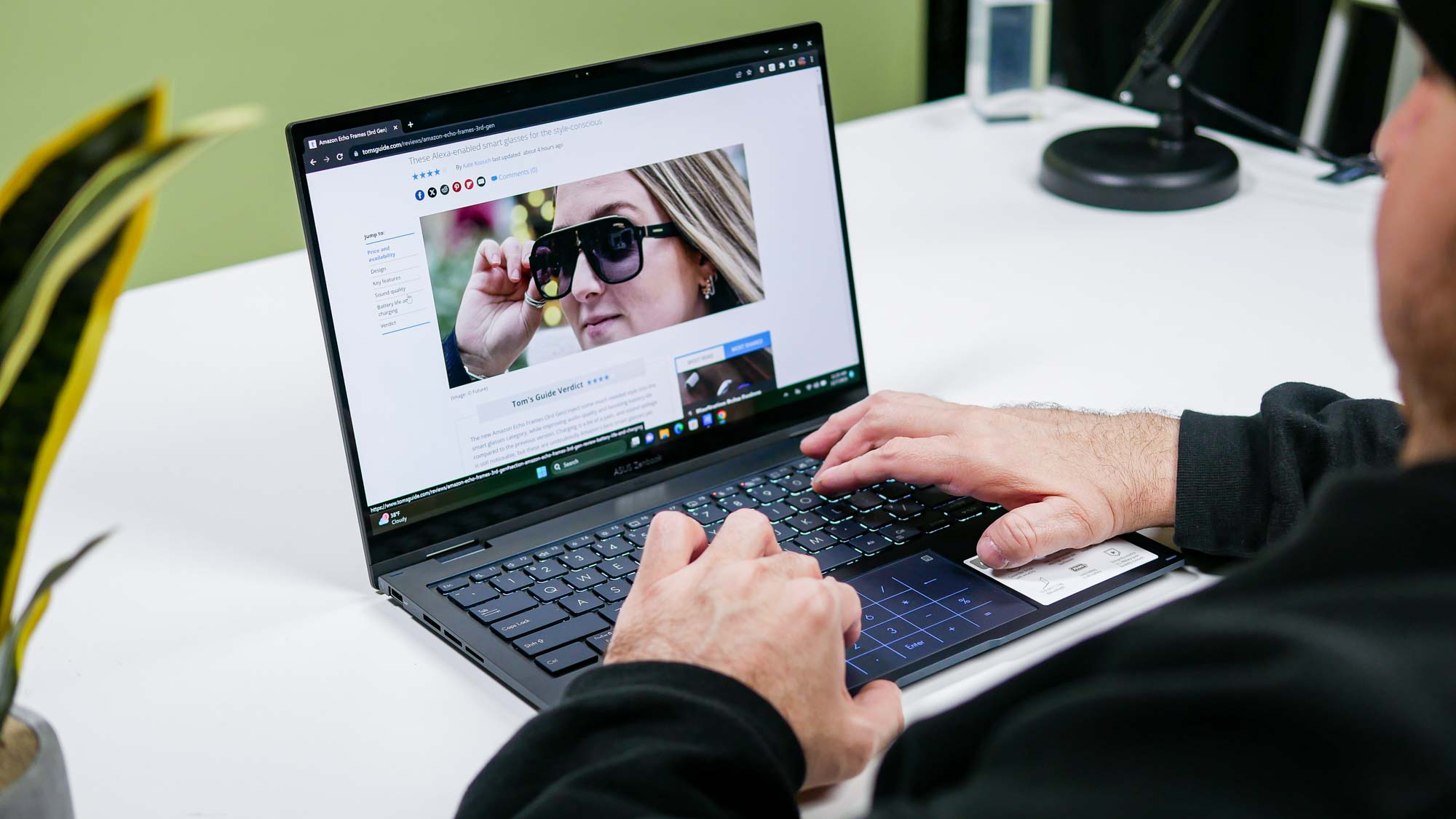
The Zenbook 14 Flip’s integrated GPU isn’t ideal for playing most modern video games. For example, Sid Meier’s Civilization VI, which isn’t a graphically demanding game, ran at a choppy 23 frames per second at the native 1,800p resolution.
However, it managed to run at 32 fps at 1,080p, which is the bare minimum you’d want for playing games. As I always say about laptops lacking a discrete GPU, do yourself a favor and use a game streaming service like Xbox Game Pass or GeForce Now for a better gaming experience.
Asus Zenbook 14 Flip OLED review: Webcam
- Mediocre 720p webcam
You’d think that 1080p webcams would be standard in a world where many folks continue working remotely. Unfortunately, the Zenbook 14 Flip features an ancient 720p potato cam that won’t do you any favors during video calls.

I took the photo above in our office. Despite the ideal lighting conditions, the image is blurry and washed out. Color reproduction isn’t terrible, but the low resolution nullifies that. If you plan to video chat on this laptop, make sure you use one of the best webcams instead.
Asus Zenbook 14 Flip OLED review: Battery life and heat
- Nearly 9-hour battery life
- Runs slightly hot
The Asus Zenbook 14 Flip OLED’s battery life is good, but not great. On the Tom’s Guide battery test, which involves continuous web surfing over Wi-Fi with the display set to 150 nits of brightness, it lasted for 8 hours and 53 minutes. That’s better than the Galaxy Book 3 Pro 360 (7:46) but over an hour less than the Yoga 9i Gen 8 (10:10).
In our standard heat test, which involves running a heat gun over a device after streaming 15 minutes of full HD video on it, we found the hottest point to be on the underside, which peaked at 96.5 degrees Fahrenheit.
We generally consider temperatures over 95 degrees as being uncomfortable. The Zenbook 14 Flip exceeds that temperature by a degree and a half, which might not make a difference to some. Still, it might be wise to keep this notebook on a desk instead of your lap when you’re using it.
Asus Zenbook 14 Flip OLED review: Verdict
The Asus Zenbook 14 Flip OLED isn’t perfect. Its 720p webcam is from a bygone era and its 9-hour battery life is short in comparison to the best MacBooks. That said, its strengths are substantial.
The sharp OLED display is wonderful for watching videos, and it has one of the best laptop keyboards I’ve tested. I also love the minimalist design and zippy performance. The LED number pad is also a nice touch. Combine all this with the fact it’s $1,199 at its most expensive, and this device becomes all the more attractive.
While the Zenbook 14 Flip OLED is now my favorite 2-in-1, the Samsung Galaxy Book 3 Pro 360 and Lenovo Yoga 9i Gen 8 are solid alternatives. Both feature the same 13th Gen Intel Core CPU, convertible design and OLED displays. At $1,449, Samsung’s notebook is pricier but could be worth it if you’re invested in the Samsung ecosystem. Lenovo’s $1,049 laptop is a good choice if you want slightly better battery life and performance.
Overall, the Asus Zenbook 14 Flip OLED provides excellent value for what it offers. If you’re looking for a dependable 2-in-1 with a svelte design and eye-pleasing OLED panel, this is the machine to get.







